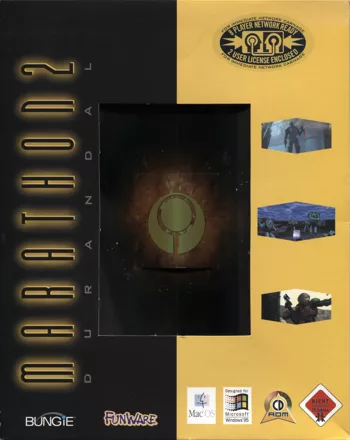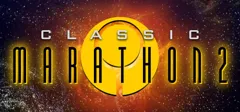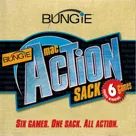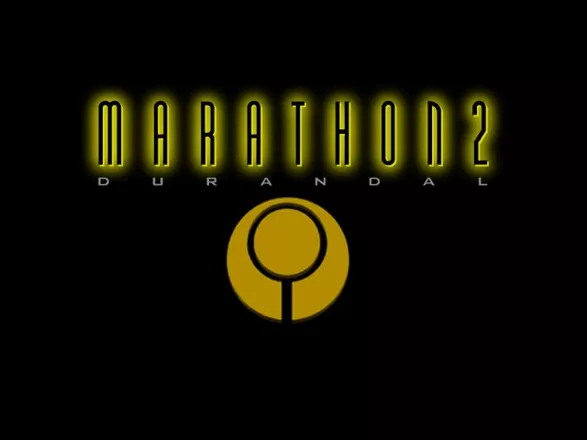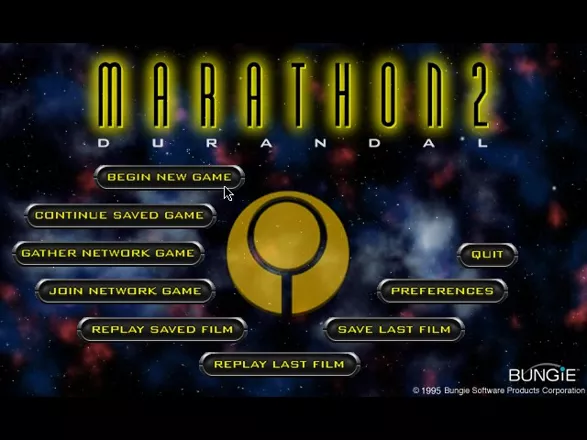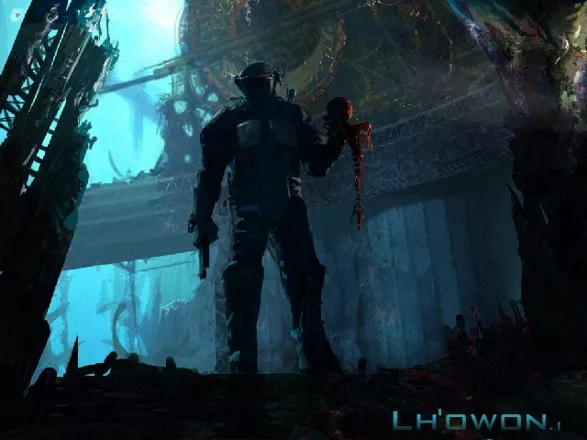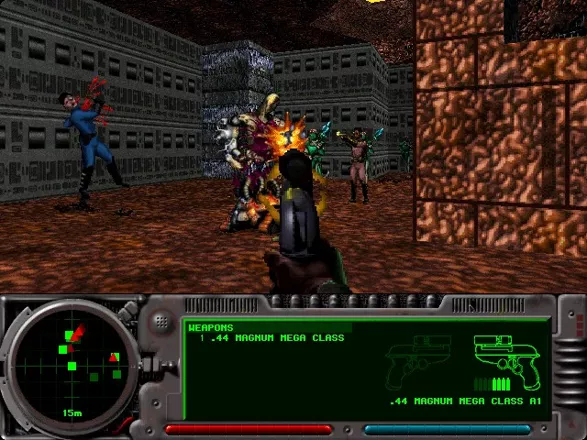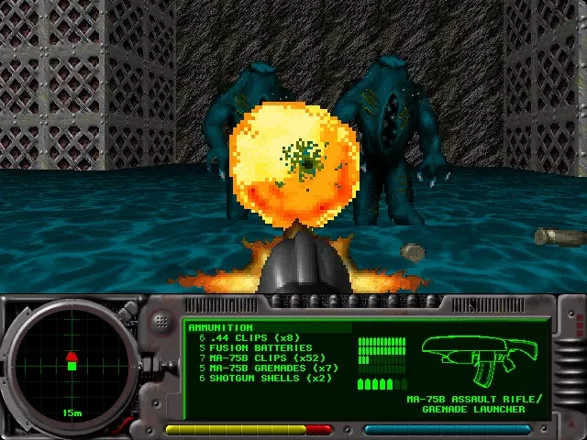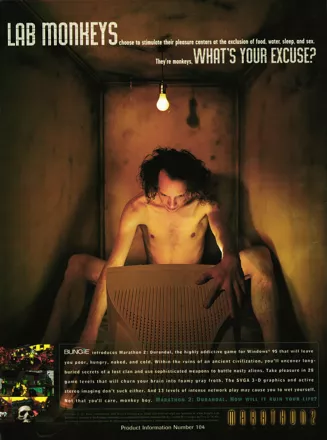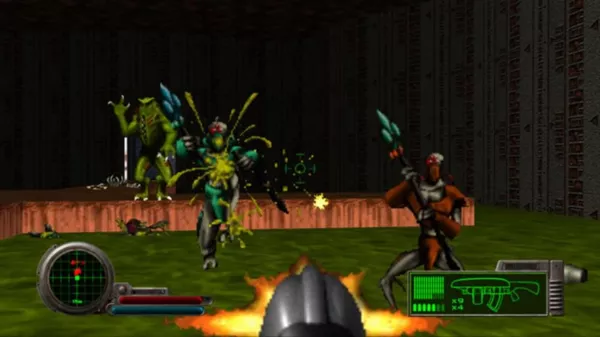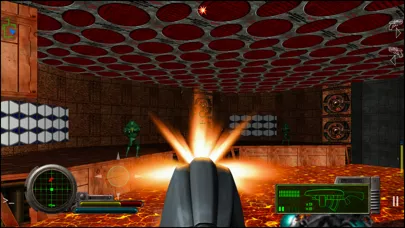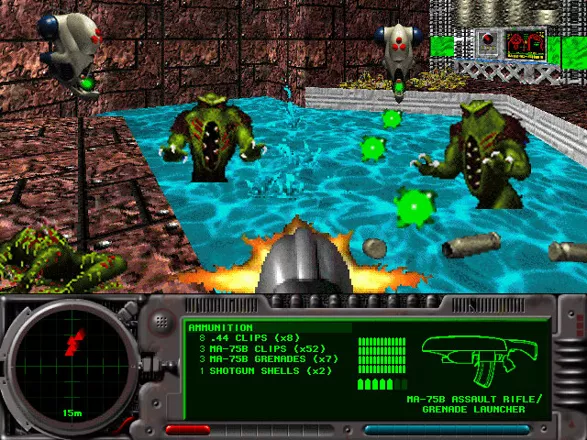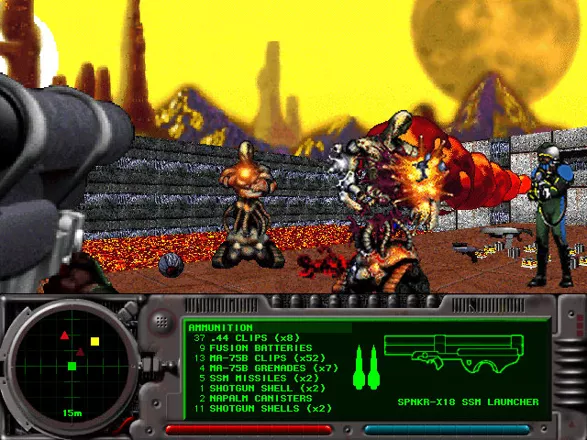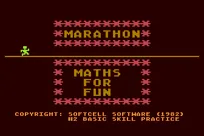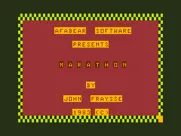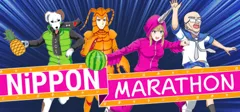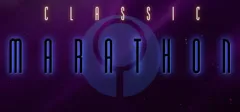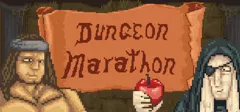Marathon 2: Durandal
Description official descriptions
Marathon 2: Durandal is the sequel to the first game. Following the events of the Pfhor aliens have been defeated and the A.I. known as Durandral has been freed from it's containment. 17 years have passed and Durandral has assembled his own army from the colonists of Tau Ceti, including the Security Officer. Traveling across the galaxy, Durandral finds the home world of the S'pht, a Pfhor slave race, who Durandal liberates and who now worship Durandral as their Messiah. Durandal is searching for the location of a legendary lost tribe of S'pht who may hold the key to his mad quest for... well, whatever he's madly questing for. Unfortunately, the Pfhor dislike Durandral's presence and begin attacking his army.
Although the engine is similar to Doom in most respects (2.5D maps, bitmap sprites instead of polygons, etc.), Marathon 2 distinguishes itself with such features such as: a rudimentary inventory system, ambient sound, multiple fire modes for each weapon, allies who aid the player, enemies belonging to different factions which will attack each other, a more developed plot (gradually narrated to the player at various computer terminals scattered throughout the levels (much like System Shock's e-mail transmissions)).
The game's engine has gained a number of improvements over the original. It now displays in a much larger portion of the screen, supports maps with four times the complexity and adds support for liquids and swimming. All liquids use oxygen when the player is submerged and some also do damage. Many levels have mechanisms allowing areas to be flooded or drained, changing the depth of the liquid.
The other major new feature is a bunch of new multiplayer modes. The entire single-player portion can be played cooperatively with up to eight players and the game adjusts weapon and monster placement accordingly. In addition to "Every Man for Himself" mode (essentially deathmatch), it now includes "Kill of the Hill" where the object is to occupy a designated spot on the map more than anyone else, and "Kill the Guy with the Ball" where the object is to hold a skull the longest, the player holding it being unable to fire weapons.
Groups +
Screenshots
Promos
Credits (Macintosh version)
28 People (17 developers, 11 thanks) · View all
| Product Design | |
| Programming | |
| Art & Graphics | |
| Sound Design | |
| Story | |
| Scenario Design | |
| Chapter Screens | |
| Title Theme |
|
| Damage & Spin | |
| The Voice of Bob | |
| German Localization |
|
| Special Thanks | |
| [ full credits ] | |
Reviews
Critics
Average score: 71% (based on 26 ratings)
Players
Average score: 3.8 out of 5 (based on 52 ratings with 3 reviews)
A forgotten FPS classic (that actually works under windows xp today!)
The Good
The Mac has never been an incredible games platform, and back in '94, aside from the noteworthy Lucasarts productions, there was basically nothing to play. Then Bungie dropped Marathon on us. During the Marathon era of Mac gaming, ie from the time Marathon was released to its second sequel went gold, it was a good time to be a Macintosh gamer. Marathon was everything Doom was, with knobs on, and it started off with a chain of features that for the time were real innovations, ranging from dual firing modes for weapons and ammo clips/reloading through advanced enemy behaviors with multiple attacks to an incredibly elaborate storyline that's still being sifted through for secrets today. Marathon was also one of the most modded games of its time, with Bungie releasing community created mods way before the PC had heard of Halflife and CS. Marathon was, if not technically, a far better game than Doom ever was from a design point of view, and Marathon 2, though substantially less impressive than the first, continued this trend of innovation and limitpushing.
Marathon 2 introduced an updated graphics engine, serving players dynamic and exciting environments with such features as pseudo-dynamic lighting, moving water with currents, spritebased props rendered from 8 directions (wheras doom had one direction; this step toward real 3d was later put into great use in Ken Silverman's Build engine, used for Duke Nukem 3d, Blood and Shadow warrior), and an incredible story taking the player from planetside exploration and conquest to boarding and taking alien battleships. Marathon and its sequels had true objective based missions, one particularly memorable one tasking you with breaking safety valves in an underground installation, flooding the place with lava, thus forcing you to make a desperate run for it to avoid being cooked.
One severely overlooked element of Marathon 2s gameplay was the extremely visceral battles. In a foreshadowing of Bungie's Halo, combat followed a flow of enter and retreat, going in with guns blazing and retreating while reloading and reevaluating the situation. In Marathon 2's sometimes chaotic battles of bouncing grenades, charging staff wielding aliens, flying drones with rapid fire lasers and roaring sewer beasts, keeping a keen eye on your surroundings often meant the difference between life and death. Another element of gameplay accented in Marathon but downplayed in its contemporaries was strafing, with dedicated keys for left and right sidestepping, making Marathon one of the first true "circle strafers".
Marathon's weapons deserve special mention. The rapid fire assault rifle/grenade launcher is still one of the most versatile weapons ever balanced for an FPS, and the multitude of weapons and uses made picking the right tool for the job a game in itself.
If Marathon 2's single player wasnt a great experience, the multiplayer features were absolutely amazing. Marathon 2 pioneered King of the hill and Kill the guy with the ball (echoed in Halo) modes now popular, and packed an extremely robust cooperative mode, with automatically adjusting difficulty levels. In the company of good friends on a company/school LAN, Marathon was the king of kings for multiplayer action of any sort.
The Bad
The PC conversion is very accurate as far as the gameplay goes, but it features a host of incredibly annoying bugs, including crashes to desktop and a save system that often refuses to let you name your own games. Another problem is the jittery mouse support, making playing the game in the newschool fashion of mouse/keyboard a bit of a hassle, particularly as the camera autocenters. Playing M2 the oldschool way of keyboard only can be strange to some, but no issue for those used to playing first person shooters with console controllers.
The Bottom Line
For its time, strikingly original and groundbreaking, but painfully overlooked by a PC community hellbent on graphics-over-gameplay. Definitely worth checking out for any fan of Halo, and a great source of inspiration for game developers looking for seeds of originality.
Windows · by Andreas SJ (21) · 2004
A classic finally comes to a platform people actually own and play games on
The Good
Marathon 2 is one of the great classics of Macintosh gaming. Upon release, Mac publications ate it up with lots of 90%+ scores. It managed to retain everything that was good about the first Marathon, while telling a significantly different story and adding a host of technical improvements and new modes and features. It was not only more advanced than its predecessor, but well ahead of anything on DOS or Windows at the time, which hadn't yet moved past the Doom engine.
On top of that, it told a damn fine story. Durandal, an insane computer and a villain of sorts in the first game, has kidnapped you and hauled you to the S'pht homeworld in hopes of uncovering a lost civilization there. The plot is largely separate from the first game, so you needn't have played it to follow things. It's very well written with conversations with various characters where you get your marching orders and move plot along, all of whom are distinct, and none of whom are stereotypes along with various bits intended to give you background information and add to the atmosphere.
Many people think of Doom when first seeing Marathon, especially back in the day before first-person shooter was an established genre. There is a superficial similarity. They're both sprite-based first-person games with similar graphical capabilities as far as resolution and color depth. However, the style is quite different. While Doom seems to draw from heavy metal album covers as its primary inspiration, Marathon is far more colorful and science-fictiony and far more technically adept.
It's somewhat more complex as well. Doom is deliberately simple in design. You find keys to get to the exit and kill anything that gets in your way. Marathon: Durandal has much more variety. Granted, a lot of the this variety amounts to finding and flipping a switch, but there are exploration missions, extermination (where all enemies must be killed) repair missions (which amount to finding a chip and putting it in a socket) as well as the standard opening doors to the exit.
The real variety comes from the environments. Levels can be cramped hallways like “For Carnage, Apply Within,” expansive pump stations that you drain and flood like “Bob’s Big Date” or the complex lava works of “All Roads Lead to Sol,” a cathedral of sorts in “Ex Cathedra,” the internals of a giant computer in “This Side Toward the Enemy” or some sort or underground mechanical works in one of the game’s most memorable levels, “What about Bob?”.
The architectural variety is made possible not only by the dynamic fluids, but by four texture sets that manage to be rather robust even with only thirty-odd textures each and an engine that allows relatively (for the time) complex room-over room structures without trickery, though no true bridges.
Enemies don't just rush you and attack. This isn't to say they have terribly complex behaviors, but it isn't just you against them. Some creatures are your allies. There are several distinct groups of enemies that fight with each other. Even allies can get pretty pissed off over misunderstanding and start attacking over friendly fire. This applies to you and your enemies.
One of Marathon's better points is the guns. While not as balanced as Bungie's later efforts such as Halo, it avoids the common system of the time of constant upgrades where each weapon you find is more powerful than the last. There are eight total weapons. Unlike many games in the genre, your melee attack (fists) isn't a nigh-useless weapon of last resort. Its damage is based on your forward momentum and a single solid hit will kill many of the weaker enemies. It's also fast enough that you can twitch-lock a lot of the stronger enemies if you catch them alone. Even the fairly standard weapons are given a novel treatment. Pistols and shotguns can be dual-wielded for twice the killing. The rocket launcher has two barrels, making for unique timing, and then there are the weapons you won’t see in most games, like the chargeable fusion pistol, the assault rifle which is a grenade launcher and machine gun in one, the very effective flamethrower, and most bizarrely, the alien weapon which shoots fireballs and has no ammo display.
Marathon 2 is a proto-Halo in many ways. Many of the weapons are very similar, the storytelling sensibility has much in common barring technological differences; it deals with an alliance of aliens looking for the ancient wisdom of a different group of aliens and, most importantly for gameplay, features a cybernetic badass with recharging health in the lead.
More than any other feature, Marathon's health system makes it play differently than its contemporaries in the genre. In most games, you have a health counter which you drain by getting hit and fill by picking up health items from the environment. In Marathon, you still have the health bar but for the most part, you do not recharge by finding items. Rather, there are recharge stations built into the walls you can use. There are several types and can recharge your health to 1X, 2X or 3X. This means you have a health supply which is not limited by amount, only geography, freeing you to behave in a far more reckless manner, so long as you are ready to retreat. This focus on retreat is not seen in other games of the era in this genre. Essentially, rather than killing your way to the exit, each level becomes about finding a health station and pattern buffer and using them as a home base to clear the level.
The pattern buffers are the save mechanism. If you only like save anywhere games, you won't be happy. I, however, always thought it was cheap to inch your way to victory a few seconds at a time. Marathon's saves are only allowed in particular locations (though without any limit on quantity).
And that’s just the single player. Marathon 2 improves both on the original Marathon and on every other game in the genre at the time in multiplayer. It’s not just the usual deathmatch. In fact, deathmatch isn’t even an option, though this port does have something called deathmatch. Rather than calculating your score as kills minus suicides and environment kills as in deathmatch, your score is kills minus deaths. As you lose points by being killed by another player, a much more cautious style of play is encouraged than in most shooters. While it’s hardly Rainbow Six, finding choke points and other defensible locations is critical.
Other games include King of the Hill, where you must hold a spot on the map for the most time, Kill the Guy with the Ball, where you must hold a ball (a human skull) for the most time, and Tag, a reversal of this concept where you must be it the least amount of time and must kill another player to make them it.
Team play is allowed and you are not restricted to two teams. There is no limit, in fact. Theoretically, you could have two teams of two up and four singles and teams are allowed in all game types except cooperative, where everyone is on a single team.
Co-op goes beyond what was commonly allowed at the time. It’s not restricted to two or four players, but eight. Obviously, this requires a second Xbox and TV. It’s isn’t just throwing more players into existing maps either. More enemies and items are added to keep the game balanced for however many players you have. A few days after getting this I played a five player co-op game most of the night instead of sleeping and got most of the way through the game. It will hook you.
One character deserves special mention: Bob. Bobs are friendly characters who fight alongside you. They only say a couple dozen things, but have memorable delivery all around, though an annoying habit of claiming credit for your kills. Even better are the robot impostors that will rush you and explode why saying ludicrous things like “Frog blast the vent core.” In “God Will Sort the Dead” you have a pit where you can get these guys going in a chain reaction like popcorn. Of course, they look just like the regular ones, leading to misunderstandings and hurt feelings.
All the monster types come in several varieties, meaning the twelve types go a lot farther than they otherwise would. There are orange/red, green, blue and purple varieties with most monster types having at least three of these. The variants may just be tougher or have more firepower, but some have different abilities. For instance, the orange and blue fighters have projectile attacks and the green and purple only have melee. There’s a blue hunter head-and-shoulders taller than the others that explodes violently on death and so on making for an actual line-up of thirty-two monster types.
So it was a great Mac game back in 1996, but is it a great Xbox 360 game in 2007? Much has been done to bring it up to date. The most immediately obvious aspect of this is the graphics. Marathon 2 used 256 indexed colors per collection with 128x128 textures and characters that were about 100 pixels tall. Everything has been (optionally) redone in beautiful full color and about four times the resolution, which is good, because it's also running at four times the screen resolution. Between this and the hardware rendering, nothing ever gets blocky nor does it even get blurry unless you're right up against something, and it's not too bad even then. The pseudo-3D trickery of the original has been replaced with a true 3d engine, though this is a subtle difference.
The interface has been revamped as well. Marathon 2 was always a widescreen game, with the interface taking up the rest of the screen. You could play in 4:3, but you would lose the interface to do so. Now, the interface has been moved up onto the play field and made semi-translucent so as not to waste so much space. Also, optional crosshairs have been added so you no longer have to guess at where the center of the screen is. Each weapon has its own cross hair which represents its firing characteristics. These are small tweaks, but make the game more playable.
The multiplayer was good to begin with as I said, but you are no longer limited to LANs, which with their requirement of hauling a bunch of people and computers within a few dozens meters of each other are not exactly convenient. Now, you have all the options of the original in split-screen and online (with Xbox Live Gold) and whatever combination you desire. I had never actually managed to get an eight-player game together before this version and now it’s as easy as waiting a few minutes in the lobby.
One small change I liked is that the minor compilers (the red ones with the yellow attack) have had their character designs put back in Marathon 1 style, which a lot of people liked better. There’s also a postscript on a secret credit terminal with info about the port.
There are a few tweaks to the saving system that affect gameplay. In the original, if you died, you went back to your last save, or if you hadn’t saved, the beginning of the game, no exceptions. Here, you go back to the beginning of whatever level you are on if you haven’t saved in the current level, saving you some annoying repetition. Additionally, if you die a bunch of times in a row, you go back to the beginning of the level, making it harder to get stuck in an unwinnable situation.
There is a brand new mode called survival where you are spawned in one of four random levels. The overall structure of each is unique, but all of them have all the weapons, occasional health canisters and start with fighters and as you kill them move up to stronger and stronger enemies. The object is to stay alive as long as possible. This is a whole level of insanity you won’t find in the main game, which because of technical limitations of the original platform is limited to about four enemy types per level and about a dozen at a time. Here, you could find all twelve at once with about forty total all around firing at you.
Like any 360 port, we now have achievements. They have managed to include a great deal of variety in their limit of 12. We have the usual ones for things like beating the game or winning a multiplayer match, one for wracking up impressive kill-counts with several weapons (easy to do really cheaply on local games, though) and a few esoteric ones for things like killing your allies or beating the games on the highest difficult while flipping switches with your fists instead of the action button and killing your allies. The only one that requires Xbox Live Gold is a zero-point viral.
The Bad
Some of the replacement character graphics aren't nearly as nice as the texture replacements. The main offenders are the fighters, who seem to be wearing skirts, and the Bobs, who have had all color drained from their jumpsuits. I also wonder why, as long as they were going HD, no one went the extra mile and rendered the characters from eight angles instead of five. This has the effect of any asymmetrical character (except the S'pht'Kr, who were done from eight angles) popping from left-handed to right and vice-versa as you circle them.
A lot of the finer points of the game aren’t explained to the newbies. This is a game from an era where you were expected to read manuals and it doesn’t have one, so it can be problematic. It does have a help file, but it contains considerably less information. It doesn’t explain the weapon functions, for instance, and has less backstory.
Several long-standing bugs are retained. Marathon 2 came from a day where 32 MB was a lot of memory and 8 MB was the minimum requirement. This was rather tight and there were lots of memory-budgeting features added. Some of these have stuck around, even though the Xbox 360 has 64 times the memory of the old minimum system. The main annoyance is the limit on the number of active monsters. You often end up with a monster just standing around not attacking because the limit has been reached and it isn't very good at deactivating the old ones. This is particularly the case in large co-op games on high difficulty levels as both add extra monsters. Each monster has a specific requirement to be activated and sometimes these aren’t counted as met for whatever reason even when you aren’t at the limit, leading to monsters that just stand there until you walk up and punch them. Punching their buddy standing right beside them doesn’t do the trick, even when their boots get splashed with his blood.
Other design flaws from the original are retained. For instance, in co-op games, there may be one guy with a rocket launcher and he falls in the lava, leaving no way to get it back. In some levels, you can lose all switch-flipping weapons in this manner and get stuck. You'll find yourselves constantly respawning with nothing but a pistol, three clips and your own two fists. Also, you're always back at the original starting place, which in a few levels means spending three or four minutes hiking back to the place you died. 6000 Feet Under is a big offender here. This is one of the places where the most improvement was needed. They did make all carried weapons always drop, which helps, and online play is a big deal, but they needed to go farther.
Co-op has other, related problems. You are only allowed to start at the first level or “Big House,” where you lose all your weapons, so it’s essentially a fresh start. I can see what they were going for here. In all other levels, you would normally be entering with weapons and they want to make sure you aren’t coming in unprepared. However, this happens when you die anyway. The game is quite long. It’s 28 levels and most are not trivial. There is no saving in multiplayer. Unless you and all your friends have six or seven hours to kill in a single sitting or know the levels pretty well, you won’t be able to get through the first segment. The original lets you start on any level in co-op and it gives you extra weapons throughout to compensate. The extra weapons are still there and everything. Out of all the changes, this is the one I liked least.
Because of some sort of oddity in how it checks to see whether you're standing on solid ground, when going down stairs or an elevator, you can’t get traction with the floor and slide around under essentially air control. This happens even on elevators moving at moderate speeds. This is made more irritating by all the platforms that will crush you because you didn’t slide out in time and when you trip going down the stairs and get roasted by whatever that Pfhor goo is.
Another design annoyance comes in the level “What About Bob?” Bungie apparently thought it would be cute to put a save terminal in a place you can't leave if you didn't follow instructions earlier. The instructions warn you of this, so it's purposeful design. This isn't the days of Sierra adventures. Trying to make avoiding unwinnable saves a part of the challenge is bad design. This is even worse now than it was eleven years ago when the game was originally released.
This isn’t the only such situation. Anywhere in the game, you could save with a sliver of health and a grenade a meter from your back or an empty oxygen tank and no way to get to a recharger except swim. Having you restart levels if you die repeatedly makes this less detrimental than the original, but you could start a level in a bad spot as well and having to save multiple drafts is not something most gamers are used to.
In fact, many of the design elements are quite dated, beyond the obvious that it's a sprite-based game. A lot of these choices I liked, but some not so much. One of the main annoyances for me was the auto map. This is a 3D game where some rooms are over others, but the map doesn't distinguish, making the more vertical levels more or less impossible to read because you just end up with a mess of wall lines and no sense what you’re on and what’s above and below. Also, the AI is very simple. Even when monster do activate, they don't lead shots, defend themselves, make any sort of coordinated tactics or really do anything except pick a hostile target and attack it. Which is to say, the AI isn’t any smarter than Doom; it just attacks things other than you. There have been complaints about difficulty, but it’s actually not too hard once you learn the ropes. Just remember this game comes from an era where difficulty didn’t come from enemies outmaneuvering you. They all follow simple patterns (though not as simple as many games of the time) and difficulty comes from their firepower, number and health.
The engine has been replaced with a new true-3D creation. For the most part, this is good and has more accurate perspective than the original. However, the characters are still 2D sprites, which leads to some issues. If you are standing right next to a character and look up, they grow much larger and if you are trying to punch them, your fists start missing. If you look down, they seem to move farther away. It still limits the degree to which you can look and down for similar reasons. Sprites would just distort worse if you could look farther.
For minor annoyances, in multiplayer, every man for himself has been given the more industry-standard name of deathmatch, but the rules are not actually the same as deathmatch, so it doesn't fit.
Marathon 2 is widely held to have the weakest multiplayer maps of the series and they are unaltered here. This isn't to say they aren't good, but the maps with Infinity and the original were better and they are missing certain options like monsters on the maps. Thunderdome is a standout, though. I hope for some map packs in the future.
For another quibble, you are now given a score in single player. It doesn't tell you how it's calculated and doesn't give you a running total, so you can't figure it out yourself very easily. It only gives a total when you die in survival or when you look at the score boards between sessions in the campaign. Presumably, you get points for killing stuff, but I have no idea how much for what and whether there are other factors.
Also, for Xbox Live play, the quick match does not seem to function. I've never gotten anything with it. Luckily, you can select custom match and just not pick any options for the same effect.
The Bottom Line
Don’t buy Marathon: Durandal expecting Halo 0, but it’s a great game for single or multiplayer if you are open to the sheer oldskoolness of it. It has probably the best story of any first-person-shooter from the pseudo-3D period, a unique graphical look, lots of memorable levels and a great multiplayer mode with game types that you don’t usually see. There are lots of ways it could have been improved, particularly the single-sitting approach to co-op. Anyone who’s enjoyed older games, which typically had predictable enemy behavior and rough graphics, should be able to look past its flaws. I do recommend this, particularly to those interested in the history of the genre, where this was quite influential, or the history of Bungie.
Xbox 360 · by Ace of Sevens (4479) · 2007
Atmospheric, terrific, amazing...who needed DOOM when you had Marathon?
The Good
Even though my brother and I played the Mac version of this game and its predecessor, Marathon, it stands as a landmark in gaming...period. The atmosphere that pervaded all aspects of this ground-breaking FPS made you just want to crawl out of your skin. The sound of shell casings hitting the floor, the way you swam through water, crawling through tunnels right into an alien's face...I remember actually gasping out loud when playing this.
Most of all, this early Bungie game made it absolutely necessary to have a compelling story in this type of game. If it had reached a larger audience I believe we would see Bungie holding the esteemed place of ID instead.
Unfortunately, this game only found its way to Macheads or devotees of Bungie and therefore still hasn't received its just reward.
Oh, and let's not forget that Marathon was a NETWORK game when only DOOM and DESCENT held that distinction.
The Bad
Durandal wasn't as ground-breaking as its predecessor and was riddled with bugs. It had one of those irritating load-crash-load-crash faults that make you just want to throw it away.
Good thing I didn't. It was amazing.
The Bottom Line
This was THE one. DOOM opened the door at the same time as MARATHON. It was the "Chuck Yeager" of the early game world, a whisper, unfortunately, when DOOM was a banshee.
Windows · by Michael McKinlay (4) · 2000
Discussion
| Subject | By | Date |
|---|---|---|
| Kids these days | Ace of Sevens (4479) | Aug 6, 2007 |
| Coming to XBLA | Ace of Sevens (4479) | Jul 18, 2007 |
Trivia
B.O.B.
The B.O.B. colonists take their names from the storyline. B.O.B. stands for "Born on Board", or not born on a planet or moon.
Durandal
The subtitle, Durandal, stems from a rogue artificial intelligence that is both aiding and foiling the player through the course of the game.
Freeware release
The complete Marathon trilogy has been freely released by Bungie to the public, you can download your copy at http://trilogyrelease.bungie.org/ . Be aware that these are the original Mac releases and the W95 Marathon 2: Durandal is not included in the pack so you are going to need a Mac emulator or Aleph One (http://source.bungie.org/) to run the titles.
Source code release
In 2000, when Bungie was bought by Microsoft, the full source code was released. Ever since, people have been modding the game. There even are ports for the Linux and BeOS platform. The full development diary and all the latest binaries can be found at Bungie's source page.
Analytics
Upgrade to MobyPro to view research rankings and price history! (when applicable)
Related Sites +
-
Postmortem: Freeverse's Marathon 2: Durandal
Feature about the Xbox 360 port of Durandal written by Mark Levin. -
Aleph One
SourceForge project page of Aleph One, an open-source game engine based on Marathon 2's source code -
Marathon Central
A comprehensive hub for almost all the Marathon related resources on the internet. Includes detailed maps, walkthroughs, and even spoilers and speculations on the game's story -
Marathon Open Source
Home of the open source development on Marathon -
X360A achievement guide
X360A's achievement guide for Marathon: Durandal.
Identifiers +
Contribute
Are you familiar with this game? Help document and preserve this entry in video game history! If your contribution is approved, you will earn points and be credited as a contributor.
Contributors to this Entry
Game added by Alan Chan.
iPad, iPhone added by Jordan117. Macintosh added by Unicorn Lynx. Xbox 360 added by Ace of Sevens.
Additional contributors: Jason Musgrave, Sciere, Ace of Sevens, Macs Black, Patrick Bregger, Starbuck the Third, Titan10.
Game added February 25, 2000. Last modified November 28, 2024.


